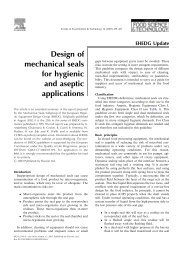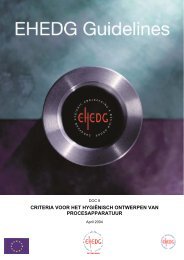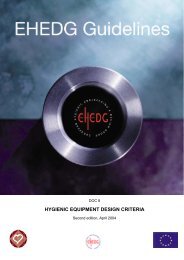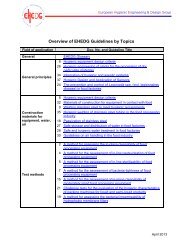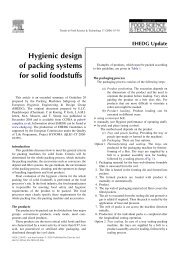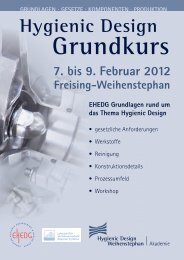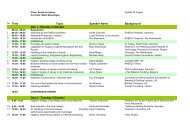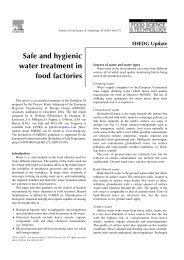Yearbook 2013/2014 - ehedg
Yearbook 2013/2014 - ehedg
Yearbook 2013/2014 - ehedg
You also want an ePaper? Increase the reach of your titles
YUMPU automatically turns print PDFs into web optimized ePapers that Google loves.
International Hygienic Study Award 2012 129<br />
layers within a liquid environment, in real time, as they are<br />
removed, enabling the influence of solution temperature,<br />
composition and shear stress to be quantified between<br />
or within experiments. It is shown to offer significant<br />
improvements over previous fluid dynamic gauge<br />
(FDG) variants, including improved resolution (±5 µm),<br />
reproducibility, automation, data quantity and the ability to<br />
generate topographical images.<br />
The sFDG is used to study the stages of swelling and<br />
removal during the cleaning of gelatine, egg yolk, starchbased<br />
and oil/albumin layers. The FDG technique could<br />
also be applied to several novel applications, including<br />
the study of crossflow microfiltration and fragile biofilms. A<br />
second-generation sFDG, optimised for cleaning studies<br />
within an industrial research laboratory, has been designed,<br />
constructed and commissioned. This technology transfer will<br />
allow the technique to contribute toward future developments<br />
in commercial dishwasher formulations.<br />
Winner of 2nd prize:<br />
Dr. Ing. Martin Schöler, University of Dresden<br />
Analysis of cleaning procedures for complex geometries<br />
in immerged systems<br />
Abstract: Industrial cleaning processes are of great<br />
importance for ensuring hygienic production conditions.<br />
Furthermore, they represent a target for economic<br />
optimisation due to their high consumption of energy and<br />
natural resources. To improve the efficiency of cleanin-place<br />
systems (CIP) it is essential to understand the<br />
mechanisms controlling complex cleaning processes. The<br />
investigation of cleaning phenomena shows two major<br />
difficulties. First, there is a need for parameters that can<br />
provide comparability between investigations that are<br />
currently isolated because they have used different material<br />
combinations or different experimental setups. Second,<br />
the availability of monitoring methods to investigate<br />
these phenomena is limited. In this work the novel local<br />
phosphorescence detection (LPD) method is presented to<br />
investigate the cleaning performance. It combines the use<br />
of complex cohesive food soil, complex pipe geometries<br />
and continuous observation of the cleaning progress to<br />
investigate the mechanisms of cleaning in immersed CIP<br />
systems. Cleaning tests on a sudden expansion were<br />
compared to soil and swelling investigations, as well as CFD<br />
results conducted by other scientists. It was shown that the<br />
tested cleaning configuration was controlled by the mass<br />
transfer of the detached parts of the soil. The mathematical<br />
parameters provided can help to determine the apparent<br />
cleaning mechanisms based on soil characteristics and the<br />
conditions of fluid flow.<br />
Interested in taking part in the Hygienic<br />
Study Award <strong>2013</strong>?<br />
Next year, drinktec in Munich will host the award ceremony.<br />
Interested research and university institutes are requested<br />
to contact Prof. Dr. Jens-Peter Majschak, TU Dresden<br />
(jens-peter.majschak@tu-dresden.de). drinktec <strong>2013</strong> –<br />
the world‘s leading trade fair for the beverage and liquid<br />
food industry – will take place from September 16 through<br />
September 20 at Munich Trade Fair Centre. Deadline for<br />
submitting abstracts is June 30, <strong>2013</strong>.<br />
Consult www.hygienic-processing.com to get full abstracts of<br />
the studies awarded.



